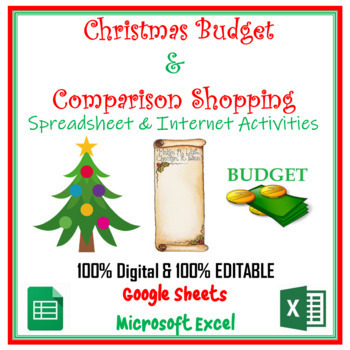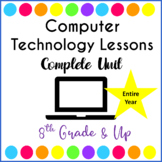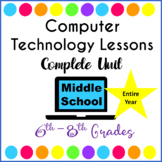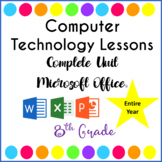Christmas Budget & Comparison Shopping Spreadsheet Activities Digital Learning
- PDF
- Google Apps™
- Internet Activities
- Excel Spreadsheets

What educators are saying
Also included in
- Celebrate the month of December with these 13 Christmas activities to keep students in grades 6-9 busy during the month of December. A wide variety of Google Apps computer skills for Google Docs, Sheets, Slides, Internet Scavenger Hunts, Digital Breakout-Escape, Interactive WebQuest, and Animation wPrice $59.99Original Price $67.25Save $7.26
- An entire year of WEEKLY Computer Technology Lessons & Activities for 8th Grade & Up. This bundle includes Computer Technology Lessons for Google Drive apps for a WEEKLY Computer Class or for classroom teachers wanting to teach Google Apps on a weekly basis.PLEASE DO NOT PURCHASE IF YOU HAVEPrice $129.99Original Price $156.94Save $26.95
- An entire year of WEEKLY Computer Technology Lessons & Activities for Grades 6th - 8th. This bundle includes Computer Technology Lessons for Google Drive apps for a WEEKLY Computer Class or for classroom teachers wanting to teach Google Apps on a weekly basis.Each lesson/activity is approximatelPrice $327.69Original Price $344.94Save $17.25
- An entire year of WEEKLY Computer Technology Lessons & Activities for 8th Grade & Up. This bundle includes Computer Technology Lessons for Microsoft Office for a WEEKLY Computer Class or for classroom teachers wanting to teach Microsoft Office on a weekly basis.Each lesson/activity is approxPrice $147.91Original Price $156.19Save $8.28
Description
This 100% Digital & 100% Editable Christmas Budget Spreadsheet, Shopping Comparison, and Internet Activity allows you, as the teacher, to customize the lessons for your students' grade level. Use the lessons as is or customize. There are two Skill Level spreadsheets included - one with calculations and one without calculations. The spreadsheet without calculations is for upper middle school and high school students familiar with spreadsheets and calculations. The spreadsheet with calculations allows younger students to learn how to comparison shop as they Christmas shop.
These lessons will teach your students how to use a spreadsheet to budget for their Christmas Shopping. The teacher sets the budget in the spreadsheet before assigning to students. Students will create a recipient list, estimate costs for the gifts, use the Internet to comparison shop (includes a Google Slides presentation to show students how to correctly comparison shop), and then enter the actual price. Students will be able to view how much money they have left to spend as they enter data.
Important: BEFORE PURCHASING, be sure your school allows student access to on-line shopping sites.
Downloads in Google Docs, Sheets, and Slides and works perfectly in Microsoft Office.
Technology Standards:
- 1.c Students use technology to seek feedback that informs and improves their practice and to demonstrate their learning in a variety of ways.
- 3.a Students plan and employ effective research strategies to locate information and other resources for their intellectual or creative pursuits.
- 3.d Students build knowledge by actively exploring real-world issues and problems, developing ideas and theories and pursuing answers and solutions.
Christmas Budget & Comparison Shopping Spreadsheet Activities Includes (100% EDITABLE)
- Link to Google Sheets Activity with Completed & Semi-Completed Examples
- Link to Google Docs Student Directions
- Link to Google Slides Presentation - How to Comparison Shop
- Teacher Directions
Also Available:
Christmas Digital Breakout Escape
Christmas Computer Skills Challenge
Creating Christmas Winter Wonderland Scenes









